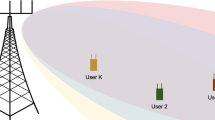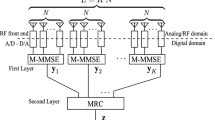Abstract
Multi-user transmission, whereby users share time and frequency resources has been an active research area in the past decade in which the uniform linear array (ULA) was proposed and implemented for its model simplicity and easy implementation. This paper studies the performance of different methods used in ULA environment and their implication to multiuser multi-input single-output (MU-MISO) scenario where the channel is considered AWGN and Rayleigh fading (slow flat fading channel). The noise power level and the effect of multipath are investigated based on the assumption that the paths have the same loss exponent and the same length (i.e. the power of the received signal are the same from different paths). The results show that the best method dependent on numerous variables, the most important being the signal to noise ratio (SNR) and the number of multipath received from each source. The implementation of these methods in MU-MISO environment reveals that they can be successfully adopted for MU-MISO. It is observed that any method applicable to ULA scenario, is also applicable to MU-MISO scenario.











Similar content being viewed by others
Explore related subjects
Discover the latest articles, news and stories from top researchers in related subjects.References
Bolcskel, H., Paulraj, A. J., Hari, K. V., Nabar, R. U., & Lu, W. W. (2001). Fixed broadband wireless access: state of the art, challenges, and future directions. IEEE Communications Magazine,39(1), 100–108.
Heath, R. W., & Paulraj, A. (2001). Characterization of MIMO channels for spatial multiplexing systems. In IEEE international conference on communications, 2001. ICC 2001. IEEE (Vol. 2, pp. 591–595).
Mietzner, J., Schober, R., Lampe, L., Gerstacker, W. H., & Hoeher, P. A. (2009). Multiple-antenna techniques for wireless communications-a comprehensive literature survey. IEEE Communications Surveys & Tutorials,11(2), 87–105.
Godara, L. C. (1997). Application of antenna arrays to mobile communications. II. Beam-forming and direction-of-arrival considerations. Proceedings of the IEEE,85(8), 1195–1245.
Bellofiore, S., Balanis, C. A., Foutz, J., & Spanias, A. S. (2002). Smart-antenna systems for mobile communication networks. Part 1. Overview and antenna design. IEEE Antennas and Propagation Magazine,44(3), 145–154.
Bellofiore, S., Foutz, J., Balanis, C. A., & Spanias, A. S. (2002). Smart-antenna system for mobile communication networks part 2 beamforming and network throughput. IEEE Antennas and Propagation Magazine,44(4), 106–114.
Gross, F. (2015). Smart Antennas with MATLAB (2nd ed.). New York: McGraw-Hill Education.
Caire, G., & Shamai, S. (2003). On the achievable throughput of a multiantenna Gaussian broadcast channel. IEEE Transactions on Information Theory,49(7), 1691–1706.
Marzetta, T. L. (2010). Noncooperative cellular wireless with unlimited numbers of base station antennas. IEEE Transactions on Wireless Communications,9(11), 3590–3600.
Goldsmith, A., Jafar, S. A., Jindal, N., & Vishwanath, S. (2003). Capacity limits of MIMO channels. IEEE Journal on Selected Areas in Communications,21(5), 684–702.
Choi, L.-U., & Murch, R. D. (2004). A transmit preprocessing technique for multiuser MIMO systems using a decomposition approach. IEEE Transactions on Wireless Communications,3(1), 20–24.
Spencer, Q. H., Peel, C. B., Swindlehurst, A. L., & Haardt, M. (2004). An introduction to the multi-user MIMO downlink. IEEE Communications Magazine,42(10), 60–67.
Gesbert, D., Kountouris, M., Heath, R. W., Jr., Chae, C.-B., & Salzer, T. (2007). Shifting the MIMO paradigm. IEEE Signal Processing Magazine,24(5), 36–46.
Viswanath, P., & Tse, D. N. C. (2003). Sum capacity of the vector Gaussian broadcast channel and uplink-downlink duality. IEEE Transactions on Information Theory,49(8), 1912–1921.
Yu, W., & Cioffi, J. M. (2004). Sum capacity of Gaussian vector broadcast channels. IEEE Transactions on Information Theory,50(9), 1875–1892.
Ng, C. T., & Huang, H. (2010). Linear precoding in cooperative MIMO cellular networks with limited coordination clusters. IEEE Journal on Selected Areas in Communications,28(9), 1446–1454.
Björnson, E., Bengtsson, M., & Ottersten, B. (2014). Optimal multiuser transmit beamforming: A difficult problem with a simple solution structure [lecture notes]. IEEE Signal Processing Magazine,31(4), 142–148.
Van Chien, T., & Björnson, E. (2017). Massive MIMO communications. In 5G mobile communications (pp. 77–116). Berlin: Springer.
Peel, C. B., Hochwald, B. M., & Swindlehurst, A. L. (2005). A vector-perturbation technique for near-capacity multiantenna multiuser communication-part I: channel inversion and regularization. IEEE Transactions on Communications,53(1), 195–202.
Tarighat, A., Sadek, M., & Sayed, A. H. (2005). A multi user beamforming scheme for downlink MIMO channels based on maximizing signal-to-leakage ratios. In Acoustics, speech, and signal processing, 2005. IEEE international conference on proceedings(ICASSP’05). IEEE (Vol. 3, pp. iii/1129-iii/1132 Vol. 1123).
Sadek, M., Tarighat, A., & Sayed, A. H. (2007). Active antenna selection in multiuser MIMO communications. IEEE Transactions on Signal Processing,55(4), 1498–1510.
Sadek, M., Tarighat, A., & Sayed, A. H. (2007). A leakage-based precoding scheme for downlink multi-user MIMO channels. IEEE Transactions on Wireless Communications,6(5), 1711–1721.
Hameed, K. W., & Abd-Alhameed, R. (2018). ULA beamforming via Schur decomposition. (unpublished).
Hameed, K. W., & Abd-Alhameed, R. (2018). On the performance of ULA beamforming. (unpublished).
Hameed, K. W., & Abd-Alhameed, R. (2018). MU-MIMO beamforming: A big picture. (unpublished).
Zhu, F., Gao, F., Jin, S., Lin, H., & Yao, M. (2018). Robust downlink beamforming for BDMA massive MIMO system. IEEE Transactions on Communications,66(4), 1496–1507.
Qin, C., Ni, W., Tian, H., Liu, R. P., & Guo, Y. J. (2018). Joint beamforming and user selection in multiuser collaborative MIMO SWIPT systems with nonnegligible circuit energy consumption. IEEE Transactions on Vehicular Technology,67(5), 3909–3923.
Wu, X., Liu, D., & Yin, F. (2018). Hybrid beamforming for multi-user massive MIMO systems. IEEE Transactions on Communications,66, 3879–3891.
Author information
Authors and Affiliations
Corresponding author
Additional information
Publisher’s Note
Springer Nature remains neutral with regard to jurisdictional claims in published maps and institutional affiliations.
This work was supported in part by the Ministry Of Higher Education and Scientific Research/Iraq.
Rights and permissions
About this article
Cite this article
Hameed, K.W., Eya, N., Noras, J.M. et al. On the duality between array beam-formers and MU-MISO precoders. Telecommun Syst 73, 105–112 (2020). https://doi.org/10.1007/s11235-019-00586-4
Published:
Issue Date:
DOI: https://doi.org/10.1007/s11235-019-00586-4




